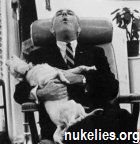rerevisionist wrote:You haven't given any detailed facts or figures on performance.
Here are some details on a 637 class submarine. http://en.wikipedia.org/wiki/Sturgeon_class_submarine I cannot supply all of the details I know as much of it is classified. What do you need that is not supplied in this link?
rerevisionist wrote:You haven't stated whether you've observed or maintained or decommissioned nuclear engines.
I have maintained and decommissioned submarine nuclear propulsion plants; if this is what you mean by "nuclear engines".
rerevisionist wrote:You haven't addressed the issue of remote recharging of batteries.
The ship's battery is re-charged by the electrical grid powered by the ship's turbine generators or shore power cables. They are not equipped to charge them in any other manner.
rerevisionist wrote:You haven't addressed the issue of how it can be possible to prevent a catastrophic fission.
I described how the reactor is inherently stable. While there is enough uranium to build a bomb in the average sub reactor, the fuel density is far too low for it to undergo a nuclear explosion as bombs do. The fuel is formed in uranium oxide pellets and they are encased in metal to protect them. Even if cooling was lost and decay activity melted the entire core into a ball, it would not undergo a nuclear explosion, but it would be very hot and emit radioactive gases.
rerevisionist wrote:Or - if you did - why it is that nuclear bombs wouldn't get hot, presumably to melting point, since for such huge amounts of energy this would be easily achieved). All you do is quote something you've read.
Nuclear bombs do not get hot because there is nothing going on to make them hot. What do you think is going to make them hot anyway? Have you determined the spontaneous fission rate of a block of fissionable material that was less than critical mass? If you have not, then why in the world would you think it would get hot?
Ranb
 [Above graphic inserted later - troll info. about this self-styled 'philosopher' -rerev]
[Above graphic inserted later - troll info. about this self-styled 'philosopher' -rerev]

